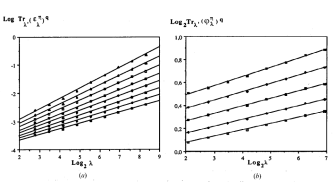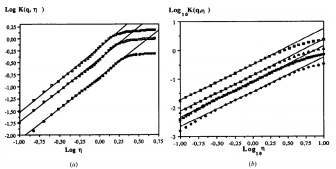Empirical estimation: turbulent flow
The characterization of the turbulent flows can be achieved using multifractal formalism, it had been showed in literature that the UM model reproduces well the statistics of the measured field in geophysics. The UM parameters have been estimated for different measured fields in geophysics, such as : velocity, temperature. We will give in this slide the estimation of
 for the wind velocity field and temperature field. The dimensional analysis performed on the Navier-Stokes equations and the advection-diffusion equation provides the expressions of fluxes which are defined as below:
for the wind velocity field and temperature field. The dimensional analysis performed on the Navier-Stokes equations and the advection-diffusion equation provides the expressions of fluxes which are defined as below:
Where
 represents the flux for the velocity field,
represents the flux for the velocity field,
 the flux for the temperature field and
the flux for the temperature field and
 the temperature variance. The data sets were measured in wind-tunnel, for the velocity: field the sampling frequency is
the temperature variance. The data sets were measured in wind-tunnel, for the velocity: field the sampling frequency is
 and the time duration is about
and the time duration is about
 , for the temperature field: the sampling frequency is
, for the temperature field: the sampling frequency is
 and the time duration is
and the time duration is
 .
.

The estimation of the UM parameters passes through the statistical moment function
 :
:

The obtained UM parameters are: for the wind velocity
 and for temperature field
and for temperature field
 .
.





